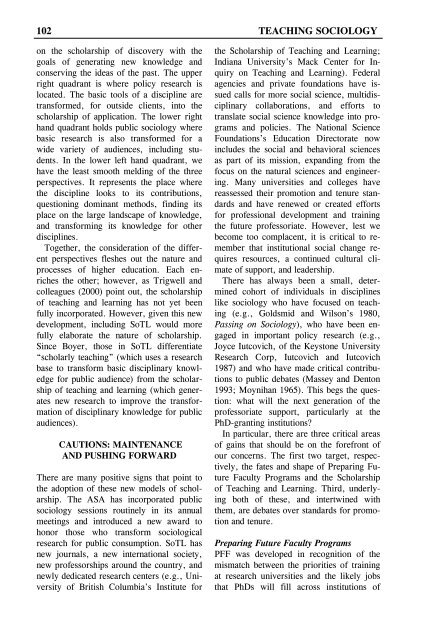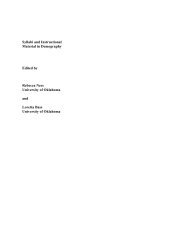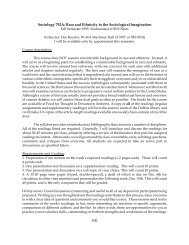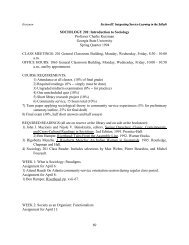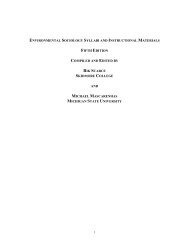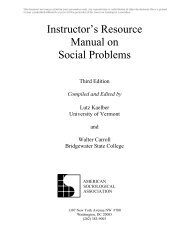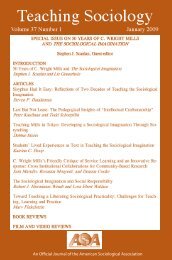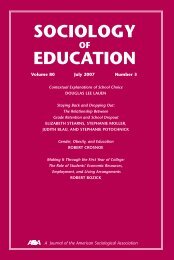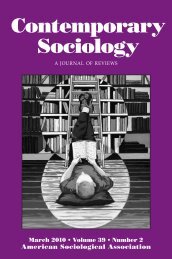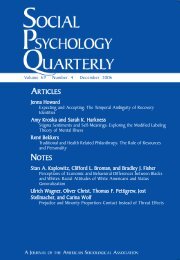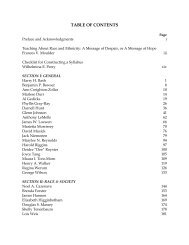3337 TS Vol36_2_APRIL 08 - American Sociological Association
3337 TS Vol36_2_APRIL 08 - American Sociological Association
3337 TS Vol36_2_APRIL 08 - American Sociological Association
You also want an ePaper? Increase the reach of your titles
YUMPU automatically turns print PDFs into web optimized ePapers that Google loves.
102 TEACHING SOCIOLOGY<br />
on the scholarship of discovery with the<br />
goals of generating new knowledge and<br />
conserving the ideas of the past. The upper<br />
right quadrant is where policy research is<br />
located. The basic tools of a discipline are<br />
transformed, for outside clients, into the<br />
scholarship of application. The lower right<br />
hand quadrant holds public sociology where<br />
basic research is also transformed for a<br />
wide variety of audiences, including students.<br />
In the lower left hand quadrant, we<br />
have the least smooth melding of the three<br />
perspectives. It represents the place where<br />
the discipline looks to its contributions,<br />
questioning dominant methods, finding its<br />
place on the large landscape of knowledge,<br />
and transforming its knowledge for other<br />
disciplines.<br />
Together, the consideration of the different<br />
perspectives fleshes out the nature and<br />
processes of higher education. Each enriches<br />
the other; however, as Trigwell and<br />
colleagues (2000) point out, the scholarship<br />
of teaching and learning has not yet been<br />
fully incorporated. However, given this new<br />
development, including SoTL would more<br />
fully elaborate the nature of scholarship.<br />
Since Boyer, those in SoTL differentiate<br />
“scholarly teaching” (which uses a research<br />
base to transform basic disciplinary knowledge<br />
for public audience) from the scholarship<br />
of teaching and learning (which generates<br />
new research to improve the transformation<br />
of disciplinary knowledge for public<br />
audiences).<br />
CAUTIONS: MAINTENANCE<br />
AND PUSHING FORWARD<br />
There are many positive signs that point to<br />
the adoption of these new models of scholarship.<br />
The ASA has incorporated public<br />
sociology sessions routinely in its annual<br />
meetings and introduced a new award to<br />
honor those who transform sociological<br />
research for public consumption. SoTL has<br />
new journals, a new international society,<br />
new professorships around the country, and<br />
newly dedicated research centers (e.g., University<br />
of British Columbia’s Institute for<br />
the Scholarship of Teaching and Learning;<br />
Indiana University’s Mack Center for Inquiry<br />
on Teaching and Learning). Federal<br />
agencies and private foundations have issued<br />
calls for more social science, multidisciplinary<br />
collaborations, and efforts to<br />
translate social science knowledge into programs<br />
and policies. The National Science<br />
Foundations’s Education Directorate now<br />
includes the social and behavioral sciences<br />
as part of its mission, expanding from the<br />
focus on the natural sciences and engineering.<br />
Many universities and colleges have<br />
reassessed their promotion and tenure standards<br />
and have renewed or created efforts<br />
for professional development and training<br />
the future professoriate. However, lest we<br />
become too complacent, it is critical to remember<br />
that institutional social change requires<br />
resources, a continued cultural climate<br />
of support, and leadership.<br />
There has always been a small, determined<br />
cohort of individuals in disciplines<br />
like sociology who have focused on teaching<br />
(e.g., Goldsmid and Wilson’s 1980,<br />
Passing on Sociology), who have been engaged<br />
in important policy research (e.g.,<br />
Joyce Iutcovich, of the Keystone University<br />
Research Corp, Iutcovich and Iutcovich<br />
1987) and who have made critical contributions<br />
to public debates (Massey and Denton<br />
1993; Moynihan 1965). This begs the question:<br />
what will the next generation of the<br />
professoriate support, particularly at the<br />
PhD-granting institutions?<br />
In particular, there are three critical areas<br />
of gains that should be on the forefront of<br />
our concerns. The first two target, respectively,<br />
the fates and shape of Preparing Future<br />
Faculty Programs and the Scholarship<br />
of Teaching and Learning. Third, underlying<br />
both of these, and intertwined with<br />
them, are debates over standards for promotion<br />
and tenure.<br />
Preparing Future Faculty Programs<br />
PFF was developed in recognition of the<br />
mismatch between the priorities of training<br />
at research universities and the likely jobs<br />
that PhDs will fill across institutions of


